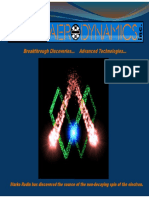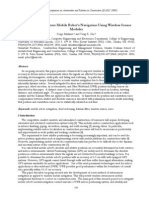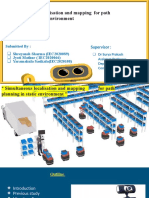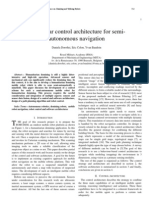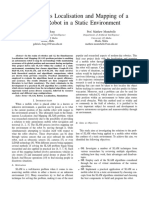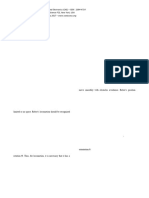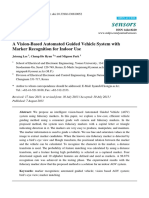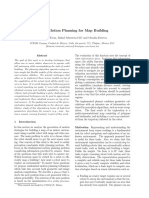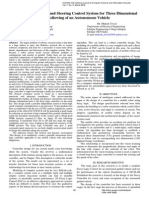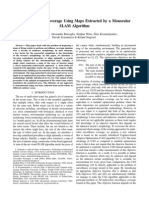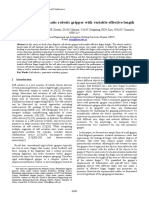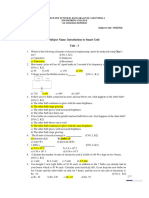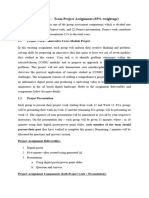Imtc RobotNavigation 7594
Imtc RobotNavigation 7594
Uploaded by
flv_91Copyright:
Available Formats
Imtc RobotNavigation 7594
Imtc RobotNavigation 7594
Uploaded by
flv_91Original Description:
Original Title
Copyright
Available Formats
Share this document
Did you find this document useful?
Is this content inappropriate?
Copyright:
Available Formats
Imtc RobotNavigation 7594
Imtc RobotNavigation 7594
Uploaded by
flv_91Copyright:
Available Formats
IMTC 2007 IEEE Instrumentation and Measurement
Technology Conference
Warsaw, Poland, May 13, 2007
Autonomous Dead-Reckoning Mobile Robot Navigation System With Intelligent
Precision Calibration
Md. Suruz Miah
1
, Wail Gueaieb
1
, Md. Abdur Rahman
2
, Abdulmotaleb El Saddik
2
School of Information Engineering and Engineering,
University of Ottawa,
Ontario, K1N6N5, Canada
1
Email: {smiah069, wgueaieb}@site.uOttawa.ca.
2
Email: {rahman, abed}@mcrlab.uOttawa.ca.
Abstract An open hardware architecture for a goal-oriented indoor
mobile robot navigation based on corrected odometry information us-
ing fuzzy logic controller is presented in this paper. The proposed
approach exploits the ability of mobile robots to navigate in unstruc-
tured, cluttered and potentially hostile environments using calibrated
odometry information, proximity sensor data and a fuzzy logic engine.
A key advantage to this technique is its simplicity over similar naviga-
tion systems discussed in the literature. The simplication stems from
the fact that only the previous traveled position of the robot needs to
be tracked to reach to the target position. The superiority of this tech-
nique is supported by the experimental results that were collected for
this purpose.
Keywords Fuzzy logic, mobile robot, dead-reckoning navigation.
I. INTRODUCTION
Navigation is a central component in most mobile robot ap-
plications. Numerous methods have been suggested in this
context over the past several years, such as landmark-based,
vision-based, and behavior-based navigation systems, to name
a few. Adopting a conventional navigation approach for sys-
tems incorporating a large number of sensors often results in a
complicated and inefcient navigation algorithm. In this paper,
we present an alternative dead-reckoning navigation technique
based on a fuzzy logic control engine. The model uses a set
of infrared proximity sensors in order to detect objects in the
environment which obstruct the motion of the robot along its
path. The path must be recomputed when unknown obstacles
are detected and sensible deviations are estimated during nav-
igation. The fuzzy rules control the orientation of the robot
according to the information about the distances from the ob-
stacles around it. The motivation of using fuzzy logic is that
distances from the obstacles are usually not precisely known.
The proposed method is cost effective and can be used in semi-
structured and unstructured environments. It is cost-effective
since only simple and low cost sensors are required.
The rest of the manuscript is organized as follows. Related
work is discussed in section II. Section III describes the over-
all system architecture. The proposed approach is detailed in
section IV. The implementation and experimental results with
a real mobile robot are presented in section V. Finally, we
conclude the paper with several remarks and future research
directions in section VI.
II. RELATED WORK
Signicant research works have been conducted in the eld
of mobile robotics that incorporate intelligent sensors. Au-
thors in [1] described a strategy and control architecture to
allow a mobile robot to navigate in indoor environment on a
planned path. The navigation system of the mobile robot in-
tegrates the position estimation obtained by a vision system
with the position estimated through an odometric technique
using a Kalman lter. The obstacle detection is performed
by several ultrasonic sensors. Their system is suitable for a
structured or quasi-structured environment and needs a-priori
knowledge of the world model. This priori knowledge is de-
signed by means of a CAD system. The CAD description is
provided to dene an initial setup of the world in order to plan
the path in advance. The indoor autonomous goal-based mo-
bile robot navigation using the cooperative strategy between
odometry and a novel visual self localization method is de-
scribed in [2]. The odometer used in their research is a dead-
reckoning sensor, which estimates only relative motion so as
to obtain the absolute position of the vehicle. The wheels of
the vehicle are equipped with encoders to measure as well as
to calibrate its relative position and orientation. The visual self
location method capitalizes on excellent angular resolution of
a CCD TV camera. The position and orientation of the vehicle
is further calibrated using this standard CCD camera. The ex-
perimental setup composed of three articial landmarks whose
coordinates are known and are imaged by CCD camera. The
orientation of the camera is estimated through the image co-
ordinates of the landmarks. Authors in [3] sketched a dead
reckoning navigation algorithm for autonomous mobile robot
which is based on a differential encoder and gyroscope. An
indirect Kalman lter is used to feedback the error estimates to
the main navigation algorithm. An indirect Kalman lter was
adopted to estimate the encoders and gyroscopes systematic
errors. The outdoor navigation system suggested in [4] uses vi-
sion and DGPS information for the position and orientation es-
timation of a mobile robot. While moving, the robot uses con-
ventional dead-reckoning and matches up the landmarks with
the environmental model for the position estimation in order to
reduce localization errors. The robot also uses vision to detect
landmarks and DGPS information to determine robots initial
position and orientation.
The problem of autonomous guided vehicle (AGV) naviga-
tion has been addressed in [5]. The approach proposed therein
is to fuse the odometry and the information provided by the vi-
sion system. A pointable camera was utilized to come up with
the vision system. The function of the camera is to be moved
in different direction to x a point in the environment while the
AGV is moving. The coordinates of the landmark are not sup-
posed to be a priori known. The camera is then responsible for
nding the coordinates of the landmark. The main difference
of the work in [5] over previous navigation methods is that any
point in the observed scene by the camera can be selected as
a landmark and not just pre-measured point. The technique
in [6] focuses on integrating encoders and Global Positioning
System (GPS) for the precise navigation of mobile robots.
Computation intelligence tools have been adopted by sev-
eral researchers for the mobile robot navigation problem in
both indoor and outdoor environments. In [7], the authors de-
signed a framework for the mobile robot that uses a Genetic
Algorithm-based navigation system. Behavior-based robot
navigation system is being adopted by several researches such
as the fuzzy logic approach in [8]. Authors in [9] describe
a fuzzy logic controller for the navigation of multiple mobile
robots with collision avoidance in a dynamic environment.
The work presented in this manuscript is signicantly dif-
ferent from previous studies in the following: 1) it deals with
the physical parameters of the sensors such as its placement in
space and time 2) the proposed navigation approach considers
two modes of operation of the mobile robot: a target seeking
mode and an obstacle avoidance mode. In the target seeking
mode robot calculates the desired orientation between its own
position and the target location called heading angle, then it
moves towards that target using its current orientation. The ob-
stacle avoidance mode is controlled by a fuzzy logic controller
to avoid obstacles that may be lying around in the environment
(more details in Section A).
III. SYSTEM ARCHITECTURE
The high level architecture of the proposed navigation sys-
tem is shown in Figure 1. The environment considered in this
paper is a oor of a building consisting of four rooms (R1, R2,
R3 and R4) with hallways between the rooms. For the proof
of concept, a scenario is dened where the mobile robot can
be utilized as a means of carrying les and/or smaller loads
from one room to another. The robot starts from initial location
(room R1 in this case) and ends in the target location (room R3
in this case) specied by the user. During navigation, robot
Fig. 1. High level architecture.
may face obstacles around its left, front and right side.
Finding the target is the main objective of the robot. A tar-
get can be any 2-D coordinate in the environment. The user
species the location of the target to the robot in the environ-
ment. The robot keeps track of target and proceeds towards
that target according to the decision generated by the naviga-
tion controller. The mobile robot uses several sensors that are
able to detect obstacles and to measure its position and orienta-
tion at any given instant of time. The next subsections describe
the fuzzy logic controller to avoid obstacles and the localiza-
tion technique of the mobile robot.
A. Fuzzy Logic Controller
Fuzzy logic control is well suited for controlling a robot be-
cause it is capable of making inferences in uncertain environ-
ments [10]. This paper shows that how fuzzy sets and fuzzy
rules can be used to represent a real system or process. Fuzzy
logic controller is responsible to change the orientation of the
robot when it faces an obstacle. This controller is activated
when the robot is in obstacle avoidance mode. The fuzzy logic
controller is composed of several fuzzy rules. Some of the
fuzzy rules are activated based on the information acquired by
the robot through its sensors. The output of the fuzzy rules con-
trol the orientation of the wheels. This change of orientation is
denoted by .
Figure 2(a) shows the Fuzzy Inference System (FIS) with
three inputs and one output. Three inputs are obstacle distances
provided by the left, right and front infrared proximity sensors
of the robot. The FIS makes the decision about . The mem-
bership variables Near, Med, High are the linguistic terms
used for the input variables LeftOD (Left Obstacle Distance),
FrontOD (Front Obstacle Distance) and RightOD (Right
Obstacle Distance). The terms NH(Negative High), NL(Nega-
tive Low), Zero, PL (Positive Low) and PH(Positive High) are
the membership variables for the output variable DeltaTheta
which is the change of orientation of the robot. The member-
ship functions are triangular or trapezoidal. The values of the
parameters are found by analyzing the experimental naviga-
tional results for different environmental scenarios. The fuzzy
rules are dened as follows in a general form:
If (LeftOD is LeftOD
i
and FrontOD is FrontOD
j
and
RightOD is RightOD
k
) Then is
ijk
where i=1 to 3, j=1 to 3 and k=1 to 3 and the values of
the LeftOD
i
, FrontOD
j
, RightOD
k
can be Near, Med or
High respectively. According to the Mamdani Fuzzy Inference
System [11], a factor ring strength for the rules is dened as
equation 1.
w
ijk
=
LeftOD
(dis
i
)
FrontOD
(dis
j
)
RightOD
(dis
k
)
(1)
Fig. 2. Fuzzy model used by the mobile robot.
where dis
i
, dis
j
, dis
k
are distance values provided by the left,
front and right infrared proximity sensors respectively. By ap-
plying the compositional rule of inference [11], the member-
ship value of the change in orientation can be computed as the
equation 2.
ijk
() = w
ijk
ijk
()
(2)
The overall conclusion can be obtained by combining the out-
puts of all the fuzzy rules using the equation 3.
() =
111
() . . .
ijk
() . . .
333
() (3)
Finally the corresponding crisp value of the change in ori-
entation is computed using centroid of area defuzzication
method [11] as shown in equation 4.
=
x
x
(x)dx
(x)dx
(4)
Where x is orientation.
For the navigation in target seeking mode, the robot simply
calculates the heading angle between its own position and the
target location using the coordinate system dened in it and
then re-orient itself and starts moving towards the target.
B. Robot Localization Mechanism
Localization is an important concern during the navigation
of a mobile robot. After a pre-dened time the robot local-
izes itself with respect to the environment. This section de-
scribes the odometry-based localization mechanism of the mo-
bile robot during navigation in the environment. The accuracy
of the odometry measurements for dead-reckoning is to a great
extent a direct function of the kinematic design of a vehicle.
Because of the close relationship between kinematic design
and positioning accuracy, one must consider the kinematic de-
sign closely before attempting to improve the dead-reckoning
accuracy. For this reason, the differential drive mobile robot
is considered for the positioning system [12]. The robot can
perform dead-reckoning by using simple geometric equations
to compute the momentary position of the vehicle relative to a
known starting position.
The physical movement of the robot falls into two cate-
gories: one is when the robot moves without any hindrance i.e.
operating target seeking mode and another one is when it faces
an obstacle on its path. If the robot faces any obstacle, it will
avoid obstacle regardless of thinking about the desired target.
So, the robot will be out of the path of the target. In that case,
robot has to localize itself and orient towards the target again.
Once the robot detects an obstacle, it updates its position (X,Y)
and orientation based on the previous position, orientation and
distance traveled (U
i
) using equation 5.
x
i+1
= x
i
+ U
i
cos
i
y
i+1
= y
i
+ U
i
sin
i
i+1
=
i
+
(5)
where
i
= previous orientation of the robot
x
i
= previous x coordinate of the robot
Equation 5 is valid for both clockwise and anti-clockwise rota-
tion of the robot. Note that, if the robot turns clockwise direc-
tion then is positive and for anticlockwise direction, is
negative. If the robot nds an obstacle around it after traveling
distance U
i
, then it will try to re-orient itself by . is
provided by the Fuzzy Inference System (FIS) [9] described in
section A.
IV. PROPOSED APPROACH
A owchart of the proposed navigation system is shown in
Figure 3. The description of each step of the mobile robot is
given below.
Fig. 3. Flowchart of the mobile robot navigation system.
textbfStep 1: The robot is initialized with the starting posi-
tion and orientation. The robot is also given the target position
where it should reach after navigation in the environment. The
starting position and target position are the (x,y) coordinates in
the given coordinate system of the environment and orientation
is the angle between the x-axis and robots current direction.
Step 2: After initialization step, the robot measures distances
of obstacles at the left, front and right direction using its in-
frared proximity sensors. The distance measurements are used
for further processing during navigation.
Step 3: This step is responsible for checking whether the dis-
tances of the obstacles at its left, front and right sides are far
enough. If these obstacle distances are far (Yes) then the robot
goes to target seeking mode, otherwise (No) it gets itself into
obstacle avoidance mode.
Step 4: There are two states in this step. One is the calcula-
tion of heading angle and based on its current position and
orientation, and other one is to extract change of orientation
provided by the fuzzy model. The rst case is for target seek-
ing mode and the second case is for obstacle avoidance mode.
Step 5: In this step, the robot will be rotated by an angle
provided by step 4 either counter clockwise or clockwise di-
rection which depends on the target or obstacles around it.
Step 6 to 8: After rotation, the robot will rst update its nal
orientation and then move straight for a predened amount of
time. The robot updates its position (x,y) based on the previ-
ous position and orientation after traveling for that amount of
time stamp.
Step 9 to 10: The robot is checking whether it has reached at
the specied target or not. If not, then it jumps to the Step 2
and continue execution of the above steps. If the robot nds the
target then it stops the navigation and exits from the system.
V. IMPLEMENTATION AND RESULTS
The mobile robot that we used for the experiment consists of
Altera Stratix Nios II FPGA board, two Futaba FPS-148 servo
motors for mobility using differential steering, both equipped
with optical sensors with incremental encoders, and infrared
proximity sensors for obstacle recognition. Two servo motors
independently control two wheels on a common axis. The dis-
tance between wheels is 20 cm, the wheel diameter is 5.5 cm,
the wheel thickness is 2.5 cm.
It is essential that an autonomous mobile robot be able to re-
cover its orientation if it becomes disoriented. At such a time,
the strategy is to realign itself and proceed until it nds the
specied target. A typical test run of the mobile robot based on
the proposed navigation method is shown in the series of pho-
tographs in Figure 4. The sequence shows the robot starts from
one corner of MIRaM laboratory (Figure 4 (a)), reorient itself
when it faces an obstacle in front of it (Figure 4 (b)) and then
travel until it nds the target (the door in this case) (Figure 4
(c)). The robots traveling velocity was 0.02m/s. Total trav-
eled distance was 15m and traveling time from starting point
to target was 13 minutes. The equivalent path of our navigation
environment is shown in Figure 5.
VI. CONCLUSION
In this paper, an efcient mobile robot navigation algorithm
using fuzzy logic controller is designed and implemented. At
rst, some necessary hardware modules are designed and im-
plemented. Then, a fuzzy logic inference is integrated in the
system to calibrate and improve its positional precision. Fi-
nally, the algorithm is tested in a real-world environment. The
algorithms performance was demonstrated through a number
of experiments conducted in our laboratories. Apossible future
research avenue to extend this work is to consider the collabo-
ration of multiple robots to navigate autonomously in a shared
common workspace.
Fig. 4. Test run of the mobile robot.
Fig. 5. Simple trajectory of the traveled path.
[1] T. DOrazio, M. Ianigro, E. Stella, F. P. Lovergine, and A. Distante, Mo-
bile robot navigation by multi-sensory integration, in IEEE Interna-
tional Conference on Robotics and Automation, May 1993, vol. 2, pp.
373379.
[2] E. Stella, F.P. Lovergine, L. Caponetti, and A. Distante, Mobile robot
navigation using vision and odometry, in Proceedings of the Intelligent
Vehicles 94 Symposium, October 1994, pp. 417422.
[3] KyuCheol Park, Hakyoung Chung, Jongbin Choi, and Jang Gyu Lee,
Dead reckoning navigation for an autonomous mobile robot using a dif-
ferential encoder and a gyroscope, in 8th International Conference on
Advanced Robotics, ICAR 97, July 1997, pp. 441446.
[4] S. Kotani, K. Kaneko, T. Shinoda, and H. Mori, Mobile robot navi-
gation based on vision and dgps information, in IEEE International
Conference on Robotics and Automation, May 1998, vol. 3, pp. 2524
2529.
[5] A. Adam, E. Rivlin, and H. Rotstein, Fusion of xation and odometry
for vehicle navigation, IEEE Transactions onSystems, Man and Cyber-
netics, Part A, vol. 29, no. 6, pp. 593603, November 1999.
[6] He Bo, Wang Danwei, Pham Minhtuan, and Yu Tieniu, Gps/encoder
based precise navigation for a 4ws mobile robot, in Proceedings of
the 7th International Conference on Control, Automation, Robotics and
Vision, ICARCV 2002, 2002, pp. 12561261.
[7] Dong-Ying Ju and Satoshi Kushida, Intelligent control of mobile robot
during autonomous inspection of welding damage based on genetic al-
gorithm, in Proceedings of the 14th International conference on Indus-
trial and engineering applications of articial intelligence and expert
systems: engineering of intelligent system, Budapest, Hungary, June 4-7
2001, Springer-Verlag, London, UK.
[8] Petru Rusu, Emil M. Petriu, Thom E. Whalen, Aurel Cornel, and Hans
J. W. Spoelder, Behavior-based neuro-fuzzy controller for mobile robot
navigation, IEEE Transactions on Instrumentation and Measurement,
vol. 52, no. 4, pp. 13351340, August 2003.
[9] Dayal R. Parhi, Navigation of mobile robot using a fuzzy logic con-
troller, Journal of Intelligent and Robotic Syst., vol. 42, no. 35, pp.
253273, March 2005.
[10] Alessandro Safotti, The uses of fuzzy logic in autonomous robot nav-
igation: a catalogue raisonne, Soft Computing Research journal, vol. 1,
no. 4, pp. 180197, 1997.
[11] F. Karray and C. D. Silva, Soft Computing and Intelligent Systems De-
sign: Theory, Tools and Applications, Pearson Education Publishing,
UK, 2004.
[12] Johan Borenstein and Liqiang Feng, Correction of systematic odome-
try errors in mobile robots, in International Conference on Intelligent
Robots and Systems, Pittsburgh, Pennsylvania, August 1995, pp. 569
574.
You might also like
- Technology and Society Social Networks Power and Inequality 3rdDocument368 pagesTechnology and Society Social Networks Power and Inequality 3rdkaja.mortensen96No ratings yet
- Artificial Intelligence in Economics and Finance Theories: Tankiso Moloi Tshilidzi MarwalaDocument131 pagesArtificial Intelligence in Economics and Finance Theories: Tankiso Moloi Tshilidzi MarwalaVega PratiwiNo ratings yet
- Fear of The Dark 2 EditionDocument138 pagesFear of The Dark 2 EditionBruce Jenkins100% (3)
- Key Words - Arduino UNO, Motor Shield L293d, Ultrasonic Sensor HC-SR04, DCDocument17 pagesKey Words - Arduino UNO, Motor Shield L293d, Ultrasonic Sensor HC-SR04, DCBîswãjït NãyàkNo ratings yet
- Rodin AeroDynamics PresentationDocument23 pagesRodin AeroDynamics PresentationAmit Kudva100% (2)
- A Method of Indoor Mobile Robot Navigation by Using ControlDocument6 pagesA Method of Indoor Mobile Robot Navigation by Using ControlengrodeNo ratings yet
- Mobile Robot Navigation Using A Behavioural StrategyDocument16 pagesMobile Robot Navigation Using A Behavioural StrategyM Taufik FirmansyahNo ratings yet
- Framework To Improve Mobile Robots Navigation Using Wireless Sensor ModulesDocument9 pagesFramework To Improve Mobile Robots Navigation Using Wireless Sensor ModulesSagheer AbbasNo ratings yet
- Final Report On Autonomous Mobile Robot NavigationDocument30 pagesFinal Report On Autonomous Mobile Robot NavigationChanderbhan GoyalNo ratings yet
- Bug Algorithms FamilyDocument38 pagesBug Algorithms FamilyAnthony FloresNo ratings yet
- 1I11-IJAET1111203 Novel 3dDocument12 pages1I11-IJAET1111203 Novel 3dIJAET JournalNo ratings yet
- Jose Luis Guzman, and Roland Siegwart : Ramon Gonzalez, Francisco Rodriguez Cedric PradalierDocument14 pagesJose Luis Guzman, and Roland Siegwart : Ramon Gonzalez, Francisco Rodriguez Cedric PradalierSaimoon QuaziNo ratings yet
- A Fuzzy Decision Making Algorithm For Safe Driving in Urban EnvironmentDocument6 pagesA Fuzzy Decision Making Algorithm For Safe Driving in Urban Environmentzphtym375No ratings yet
- Multilevel Classification Scheme For AGV Perception: Naeem Ur Rehman Dr. Sohail Asghar Shahzad Rafiq Irfan Simon FongDocument5 pagesMultilevel Classification Scheme For AGV Perception: Naeem Ur Rehman Dr. Sohail Asghar Shahzad Rafiq Irfan Simon FongBadr U ZamanNo ratings yet
- Research On Intelligent Fuzzy Control Algorithm For Moving Path of Handling RobotDocument5 pagesResearch On Intelligent Fuzzy Control Algorithm For Moving Path of Handling RobotZied TMARNo ratings yet
- Paper Khas 2014Document13 pagesPaper Khas 2014AmmarALJodahNo ratings yet
- Autonomous Mobile Robot Navigation Using Passive RFID in Indoor EnvironmentDocument8 pagesAutonomous Mobile Robot Navigation Using Passive RFID in Indoor EnvironmentGunasekar R ErNo ratings yet
- Electronically Driven Mobile PlatformDocument6 pagesElectronically Driven Mobile PlatformviduraNo ratings yet
- MIMO Fuzzy Control For Autonomous Mobile RobotDocument6 pagesMIMO Fuzzy Control For Autonomous Mobile RobotaliNo ratings yet
- RFID-Based Mobile Robot Positioning - Sensors and TechniquesDocument5 pagesRFID-Based Mobile Robot Positioning - Sensors and Techniquessurendiran123No ratings yet
- Reactive Navigation For Autonomous Guided Vehicle Using The Neuro-Fuzzy TechniquesDocument10 pagesReactive Navigation For Autonomous Guided Vehicle Using The Neuro-Fuzzy TechniquesMiguel SilvaNo ratings yet
- Your Big IdeaDocument18 pagesYour Big IdeaYuvatejasviNo ratings yet
- Fuzzy Controller Technique in Navigation of A Mobile Robot: Javed Khan, S P ShrivasDocument4 pagesFuzzy Controller Technique in Navigation of A Mobile Robot: Javed Khan, S P ShrivaserpublicationNo ratings yet
- Kothari 2017Document8 pagesKothari 2017NikitaNo ratings yet
- 3Document6 pages3Samuel HamiltonNo ratings yet
- A Modular Control Architecture For Semi-Autonomous NavigationDocument4 pagesA Modular Control Architecture For Semi-Autonomous NavigationKai GustavNo ratings yet
- FYP Review PaperDocument6 pagesFYP Review PaperMatthew MontebelloNo ratings yet
- Sensors: Pose Estimation of A Mobile Robot Based On Fusion of IMU Data and Vision Data Using An Extended Kalman FilterDocument22 pagesSensors: Pose Estimation of A Mobile Robot Based On Fusion of IMU Data and Vision Data Using An Extended Kalman Filterxyz shahNo ratings yet
- 1805 00224 PDFDocument27 pages1805 00224 PDFFENIL DESAINo ratings yet
- Robot Localization Using Relative and Absolute Position EstimatesDocument7 pagesRobot Localization Using Relative and Absolute Position Estimatesengineer86No ratings yet
- Fuzzy Logic Controller Design For Mobile Robot Outdoor NavigationDocument20 pagesFuzzy Logic Controller Design For Mobile Robot Outdoor NavigationMinh VuNo ratings yet
- Microcontroller Based Neural Network Controlled Low Cost Autonomous VehicleDocument9 pagesMicrocontroller Based Neural Network Controlled Low Cost Autonomous VehicleMihir KumarNo ratings yet
- 1 DobotDocument4 pages1 Dobotrk krishnaNo ratings yet
- Collision Avoidance of High-Speed Obstacles For Mobile Robots Via Maximum-Speed Aware Velocity Obstacle MethodDocument15 pagesCollision Avoidance of High-Speed Obstacles For Mobile Robots Via Maximum-Speed Aware Velocity Obstacle Methodabinaya_359109181No ratings yet
- Implementation of An Object-Grasping Robot Arm Using Stereo Vision Measurement and Fuzzy ControlDocument13 pagesImplementation of An Object-Grasping Robot Arm Using Stereo Vision Measurement and Fuzzy ControlWikipedia.No ratings yet
- 006 Model Predictive Control For Positioning and Navigation of Mobile Robot With Cooperation of UAVDocument9 pages006 Model Predictive Control For Positioning and Navigation of Mobile Robot With Cooperation of UAVMoustafa KurdiNo ratings yet
- 1 s2.0 S0921889020305091 MainDocument8 pages1 s2.0 S0921889020305091 MainTri SuakaNo ratings yet
- Circumventing Dynamic Modeling Evaluation of The Error-State PDFDocument8 pagesCircumventing Dynamic Modeling Evaluation of The Error-State PDFvaseem akramNo ratings yet
- Rodriguez Mva 2011Document16 pagesRodriguez Mva 2011Felipe Taha Sant'AnaNo ratings yet
- Intelligent Mobility: Autonomous Outdoor Robotics at The DFKIDocument7 pagesIntelligent Mobility: Autonomous Outdoor Robotics at The DFKIFernando MartinezNo ratings yet
- Fahmizal 2019Document6 pagesFahmizal 2019ShreyasNo ratings yet
- Sensors: A Vision-Based Automated Guided Vehicle System With Marker Recognition For Indoor UseDocument22 pagesSensors: A Vision-Based Automated Guided Vehicle System With Marker Recognition For Indoor Usebalakrishna88No ratings yet
- Navigation For An Intelligent Mobile RobotDocument11 pagesNavigation For An Intelligent Mobile RobotOnkar ViralekarNo ratings yet
- FICTA - Paper - Final PDFDocument9 pagesFICTA - Paper - Final PDFPratap Kumar PanigrahiNo ratings yet
- Literature SurveyDocument6 pagesLiterature SurveySanthosh Kumar NeelamNo ratings yet
- Mobile Robot Localization - Autonomous Localization SystemsDocument12 pagesMobile Robot Localization - Autonomous Localization SystemsABNo ratings yet
- Mobile Robots For Search and Rescue: Niramon Ruangpayoongsak Hubert Roth Jan ChudobaDocument6 pagesMobile Robots For Search and Rescue: Niramon Ruangpayoongsak Hubert Roth Jan ChudobaNemitha LakshanNo ratings yet
- IT-2 Fuzzy Control and Behavioral Approach Navigation System For Holonomic 4WD/4WS Agricultural RobotDocument18 pagesIT-2 Fuzzy Control and Behavioral Approach Navigation System For Holonomic 4WD/4WS Agricultural Robothemantborulaa88No ratings yet
- Sensors 10 03655Document26 pagesSensors 10 03655Hussain RizviNo ratings yet
- Evaluation of A Factorized ICP Based Method For 3D Mapping and LocalizationDocument9 pagesEvaluation of A Factorized ICP Based Method For 3D Mapping and LocalizationIan MedeirosNo ratings yet
- UNIT-2 Maneouverablity - Path and Trajectory - Motion ControlDocument6 pagesUNIT-2 Maneouverablity - Path and Trajectory - Motion Controllonely programmerNo ratings yet
- Design of An Iot Based Autonomous Vehicle Using Computer VisionDocument22 pagesDesign of An Iot Based Autonomous Vehicle Using Computer VisionyashNo ratings yet
- Literature ReviewDocument14 pagesLiterature ReviewMohammed Razwin K PNo ratings yet
- Robot Motion Planning For Map Building: Benjam In Tovar, Rafael Murrieta-Cid and Claudia EstevesDocument8 pagesRobot Motion Planning For Map Building: Benjam In Tovar, Rafael Murrieta-Cid and Claudia EstevesIulian AlexNo ratings yet
- Fuzzy Logic of Speed and Steering Control System For Three Dimensional Line Following of An Autonomous VehicleDocument8 pagesFuzzy Logic of Speed and Steering Control System For Three Dimensional Line Following of An Autonomous Vehiclealeena_bcNo ratings yet
- A Qualitative Approach To Mobile Robot Navigation Using RFIDDocument12 pagesA Qualitative Approach To Mobile Robot Navigation Using RFIDRana KhanNo ratings yet
- Science China: Information SciencesDocument11 pagesScience China: Information SciencesDilesh PradhanNo ratings yet
- Robust Localization Algorithms For An Autonomous Campus Tour GuideDocument7 pagesRobust Localization Algorithms For An Autonomous Campus Tour GuideHoangtele DangNo ratings yet
- Path Tracking of Mobile Robot in CropsDocument13 pagesPath Tracking of Mobile Robot in CropsJohn Jairo AvendañoNo ratings yet
- Fuzzy Logic Navigation and Obstacle Avoidance by A Mobile Robot in An Unknown Dynamic EnvironmentDocument7 pagesFuzzy Logic Navigation and Obstacle Avoidance by A Mobile Robot in An Unknown Dynamic EnvironmentKhaoulaMaatougNo ratings yet
- Localization Data Fusion RobotinoDocument8 pagesLocalization Data Fusion RobotinoAlexandre RibeiroNo ratings yet
- 1 s2.0 S0921889016302512 MainDocument15 pages1 s2.0 S0921889016302512 Mainfaith_khp73301No ratings yet
- 3D Surveillance Coverage Using Maps Extracted by A Monocular SLAM AlgorithmDocument7 pages3D Surveillance Coverage Using Maps Extracted by A Monocular SLAM AlgorithmAlexandreSidantNo ratings yet
- Theoretical method to increase the speed of continuous mapping in a three-dimensional laser scanning system using servomotors controlFrom EverandTheoretical method to increase the speed of continuous mapping in a three-dimensional laser scanning system using servomotors controlNo ratings yet
- Semi Eng 20mbpsDocument17 pagesSemi Eng 20mbpsflv_91No ratings yet
- Developing LIDAR Pulse Code Detection System Using PRF: M. Sarmad Mir, Jehan Zeb Shah, Abdul MajidDocument6 pagesDeveloping LIDAR Pulse Code Detection System Using PRF: M. Sarmad Mir, Jehan Zeb Shah, Abdul Majidflv_91No ratings yet
- Digital Rate MEMS Vibratory Gyroscope Modeling, Tuning and Simulation ResultsDocument13 pagesDigital Rate MEMS Vibratory Gyroscope Modeling, Tuning and Simulation Resultsflv_91No ratings yet
- PINOUTDocument1 pagePINOUTflv_91No ratings yet
- Sil Poxy Silicone AdhesiveDocument1 pageSil Poxy Silicone Adhesiveflv_91No ratings yet
- Odometry Fusion IMU - 1.5066524Document9 pagesOdometry Fusion IMU - 1.5066524flv_91No ratings yet
- Dynamic Walking RobotDocument27 pagesDynamic Walking Robotflv_91No ratings yet
- 102 Ways To Energize GroupsDocument72 pages102 Ways To Energize Groupsflv_91No ratings yet
- Domeniul Mecatronica Si Robotica Specializarea R Anul de Studii Sem. II An Univ. 2012Document1 pageDomeniul Mecatronica Si Robotica Specializarea R Anul de Studii Sem. II An Univ. 2012flv_91No ratings yet
- Universal Soft Pneumatic Robotic Gripper With Variable Effective LengthDocument6 pagesUniversal Soft Pneumatic Robotic Gripper With Variable Effective Lengthflv_91No ratings yet
- LinuxJournal January 2016 VK Com StopthepressDocument96 pagesLinuxJournal January 2016 VK Com Stopthepressflv_91No ratings yet
- COS 495 - Lecture 5 Autonomous Robot Navigation: Instructor: Chris Clark Semester: Fall 2011Document30 pagesCOS 495 - Lecture 5 Autonomous Robot Navigation: Instructor: Chris Clark Semester: Fall 2011flv_91No ratings yet
- Open Source For You - November 2014 in VK ComDocument108 pagesOpen Source For You - November 2014 in VK Comflv_91No ratings yet
- Digital Twin: Values, Challenges and Enablers: October 2019Document34 pagesDigital Twin: Values, Challenges and Enablers: October 2019jedoNo ratings yet
- Educational Technology & Society: Journal ofDocument231 pagesEducational Technology & Society: Journal ofKai Michael HöverNo ratings yet
- Icwr51868 2021 9443129Document4 pagesIcwr51868 2021 9443129Nagaraj LutimathNo ratings yet
- AIS To AIM Roadmap Explained 1 of 17 27 November 2014Document17 pagesAIS To AIM Roadmap Explained 1 of 17 27 November 2014GIS SUL AIRPORTNo ratings yet
- Korelasi Antara Fixation Eye Tracking Metric Dengan: Performance Measurement Usability TestingDocument10 pagesKorelasi Antara Fixation Eye Tracking Metric Dengan: Performance Measurement Usability TestingRizaldi IsmayadiNo ratings yet
- CCSK v5 Knowledge GuideDocument8 pagesCCSK v5 Knowledge GuidearpitvNo ratings yet
- Smart Grid MCQ AnsDocument16 pagesSmart Grid MCQ Ansvidbharathi02No ratings yet
- Silicon Valley MICDocument26 pagesSilicon Valley MICMarc JacquinetNo ratings yet
- Conjured Chaos Kisses - Ki BrightlyDocument121 pagesConjured Chaos Kisses - Ki BrightlyLouiseNo ratings yet
- 無人飛行載具空拍影像目標物件即時自動辨識與定位系統之研究Document58 pages無人飛行載具空拍影像目標物件即時自動辨識與定位系統之研究prince111299211No ratings yet
- The Digital Marketing in The AI World-Pages-PagesDocument46 pagesThe Digital Marketing in The AI World-Pages-PagesnazlaabadrNo ratings yet
- Jahnavi Product AmazonDocument1 pageJahnavi Product AmazonJahnavi ShahNo ratings yet
- Artificial Intelligence Reaction Paper 2Document2 pagesArtificial Intelligence Reaction Paper 2LuelsonCordovaDeclaradorNo ratings yet
- V2M ReportDocument26 pagesV2M ReportMuruganm92No ratings yet
- Structure BE AI DS 2020 03 072020Document5 pagesStructure BE AI DS 2020 03 072020shubham chavanNo ratings yet
- MUSKIRD - HosmartAI OC2 - Annex 3.1 Description of WorkDocument17 pagesMUSKIRD - HosmartAI OC2 - Annex 3.1 Description of WorkvaheNo ratings yet
- Team Project DetailsDocument4 pagesTeam Project DetailsKam Yao RenNo ratings yet
- BA Impact MappingDocument32 pagesBA Impact MappingИрина РудаковаNo ratings yet
- AI&DS_ND24Document6 pagesAI&DS_ND24venkatmech2013No ratings yet
- Ethical Leadership in A Digital Era Applying The IESBA Code To Selected Technology Related ScenariosDocument26 pagesEthical Leadership in A Digital Era Applying The IESBA Code To Selected Technology Related ScenariosFranNo ratings yet
- Preprints202309 1541 v1Document18 pagesPreprints202309 1541 v1Ngọc YếnNo ratings yet
- A Comprehensive Guide I ChatBot-v1.0Document38 pagesA Comprehensive Guide I ChatBot-v1.0Pri NovaNo ratings yet
- Erud AI Joins Databricks Marketplace To Elevate Data Quality and Accessibility For AI InnovatorsDocument4 pagesErud AI Joins Databricks Marketplace To Elevate Data Quality and Accessibility For AI InnovatorsPR.comNo ratings yet
- The Essentials of Machine Learning in Finance and AccountingDocument259 pagesThe Essentials of Machine Learning in Finance and Accountingernestdark11100% (1)
- 8 ChatGPT Prompts To Create Your 2024 Business StrategyDocument15 pages8 ChatGPT Prompts To Create Your 2024 Business StrategyGoKi Voregis100% (1)
- Tool Use Cases To Seize Ai Investment OpportunitiesDocument10 pagesTool Use Cases To Seize Ai Investment Opportunitieselcinmiras2No ratings yet




